PONTIAC G5 2007 Owners Manual
Manufacturer: PONTIAC, Model Year: 2007, Model line: G5, Model: PONTIAC G5 2007Pages: 428, PDF Size: 2.46 MB
Page 261 of 428
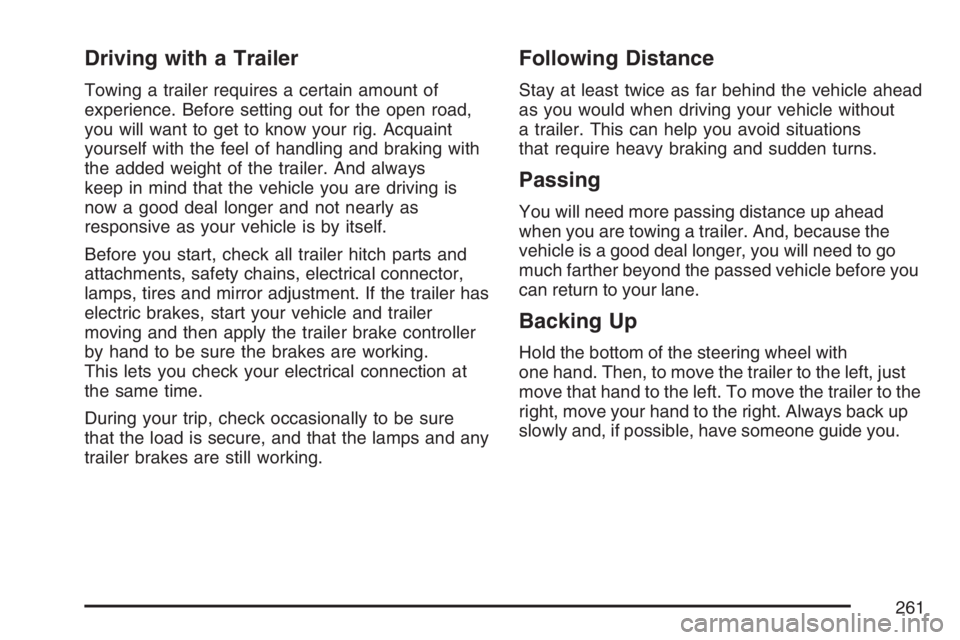
Driving with a Trailer
Towing a trailer requires a certain amount of
experience. Before setting out for the open road,
you will want to get to know your rig. Acquaint
yourself with the feel of handling and braking with
the added weight of the trailer. And always
keep in mind that the vehicle you are driving is
now a good deal longer and not nearly as
responsive as your vehicle is by itself.
Before you start, check all trailer hitch parts and
attachments, safety chains, electrical connector,
lamps, tires and mirror adjustment. If the trailer has
electric brakes, start your vehicle and trailer
moving and then apply the trailer brake controller
by hand to be sure the brakes are working.
This lets you check your electrical connection at
the same time.
During your trip, check occasionally to be sure
that the load is secure, and that the lamps and any
trailer brakes are still working.
Following Distance
Stay at least twice as far behind the vehicle ahead
as you would when driving your vehicle without
a trailer. This can help you avoid situations
that require heavy braking and sudden turns.
Passing
You will need more passing distance up ahead
when you are towing a trailer. And, because the
vehicle is a good deal longer, you will need to go
much farther beyond the passed vehicle before you
can return to your lane.
Backing Up
Hold the bottom of the steering wheel with
one hand. Then, to move the trailer to the left, just
move that hand to the left. To move the trailer to the
right, move your hand to the right. Always back up
slowly and, if possible, have someone guide you.
261
Page 262 of 428

Making Turns
Notice:Making very sharp turns while
trailering could cause the trailer to come in
contact with the vehicle. Your vehicle could be
damaged. Avoid making very sharp turns
while trailering.
When you are turning with a trailer, make wider
turns than normal. Do this so your trailer will not
strike soft shoulders, curbs, road signs, trees or
other objects. Avoid jerky or sudden maneuvers.
Signal well in advance.
Turn Signals When Towing a Trailer
When you tow a trailer, your vehicle may need a
different turn signal �asher and/or extra wiring.
Check with your dealer. The arrows on your
instrument panel will �ash whenever you
signal a turn or lane change. Properly hooked up,
the trailer lamps will also �ash, telling other
drivers you are about to turn, change lanes
or stop.When towing a trailer, the arrows on your
instrument panel will �ash for turns even if the bulbs
on the trailer are burned out. Thus, you may think
drivers behind you are seeing your signal when
they are not. It is important to check occasionally to
be sure the trailer bulbs are still working.
Driving on Grades
Notice:Do not tow on steep continuous
grades exceeding 6 miles (9.6 km). Extended,
higher than normal engine and transaxle
temperatures may result and damage your
vehicle. Frequent stops are very important to
allow the engine and transaxle to cool.
Reduce speed and shift to a lower gearbefore
you start down a long or steep downgrade. If you
do not shift down, you might have to use your
brakes so much that they would get hot and
no longer work well.
Pay attention to the engine coolant gage. If the
indicator is in the red area, turn off the air
conditioning to reduce engine load. SeeEngine
Overheating on page 290.
262
Page 263 of 428
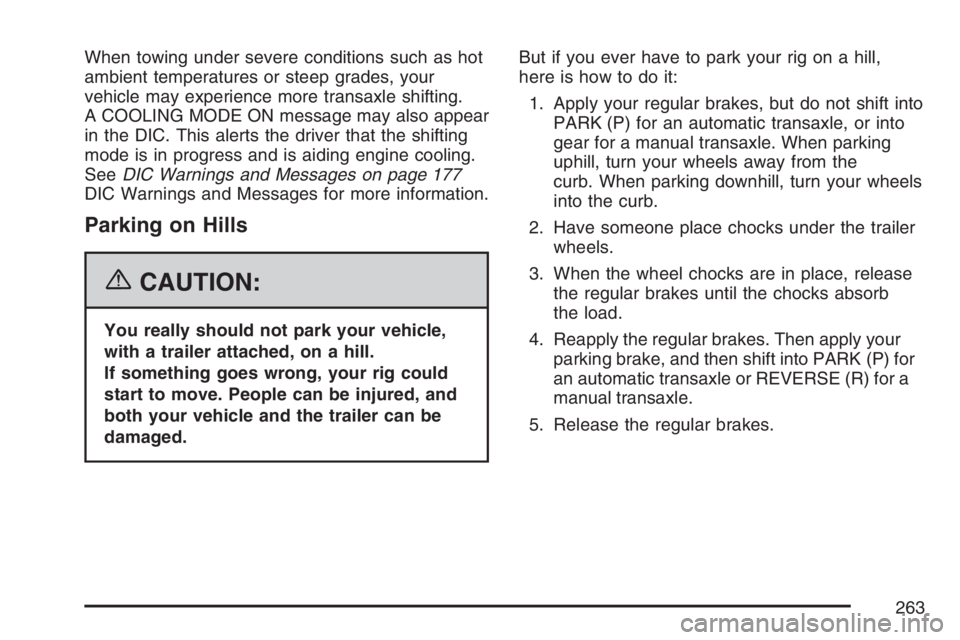
When towing under severe conditions such as hot
ambient temperatures or steep grades, your
vehicle may experience more transaxle shifting.
A COOLING MODE ON message may also appear
in the DIC. This alerts the driver that the shifting
mode is in progress and is aiding engine cooling.
SeeDIC Warnings and Messages on page 177
DIC Warnings and Messages for more information.
Parking on Hills
{CAUTION:
You really should not park your vehicle,
with a trailer attached, on a hill.
If something goes wrong, your rig could
start to move. People can be injured, and
both your vehicle and the trailer can be
damaged.But if you ever have to park your rig on a hill,
here is how to do it:
1. Apply your regular brakes, but do not shift into
PARK (P) for an automatic transaxle, or into
gear for a manual transaxle. When parking
uphill, turn your wheels away from the
curb. When parking downhill, turn your wheels
into the curb.
2. Have someone place chocks under the trailer
wheels.
3. When the wheel chocks are in place, release
the regular brakes until the chocks absorb
the load.
4. Reapply the regular brakes. Then apply your
parking brake, and then shift into PARK (P) for
an automatic transaxle or REVERSE (R) for a
manual transaxle.
5. Release the regular brakes.
263
Page 264 of 428
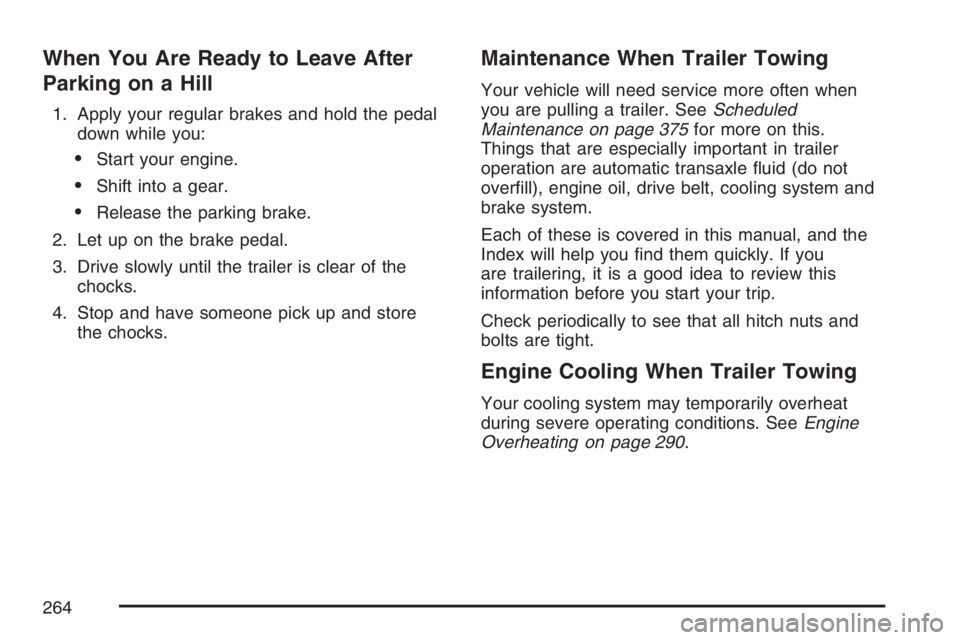
When You Are Ready to Leave After
Parking on a Hill
1. Apply your regular brakes and hold the pedal
down while you:
Start your engine.
Shift into a gear.
Release the parking brake.
2. Let up on the brake pedal.
3. Drive slowly until the trailer is clear of the
chocks.
4. Stop and have someone pick up and store
the chocks.
Maintenance When Trailer Towing
Your vehicle will need service more often when
you are pulling a trailer. SeeScheduled
Maintenance on page 375for more on this.
Things that are especially important in trailer
operation are automatic transaxle �uid (do not
over�ll), engine oil, drive belt, cooling system and
brake system.
Each of these is covered in this manual, and the
Index will help you �nd them quickly. If you
are trailering, it is a good idea to review this
information before you start your trip.
Check periodically to see that all hitch nuts and
bolts are tight.
Engine Cooling When Trailer Towing
Your cooling system may temporarily overheat
during severe operating conditions. SeeEngine
Overheating on page 290.
264
Page 265 of 428
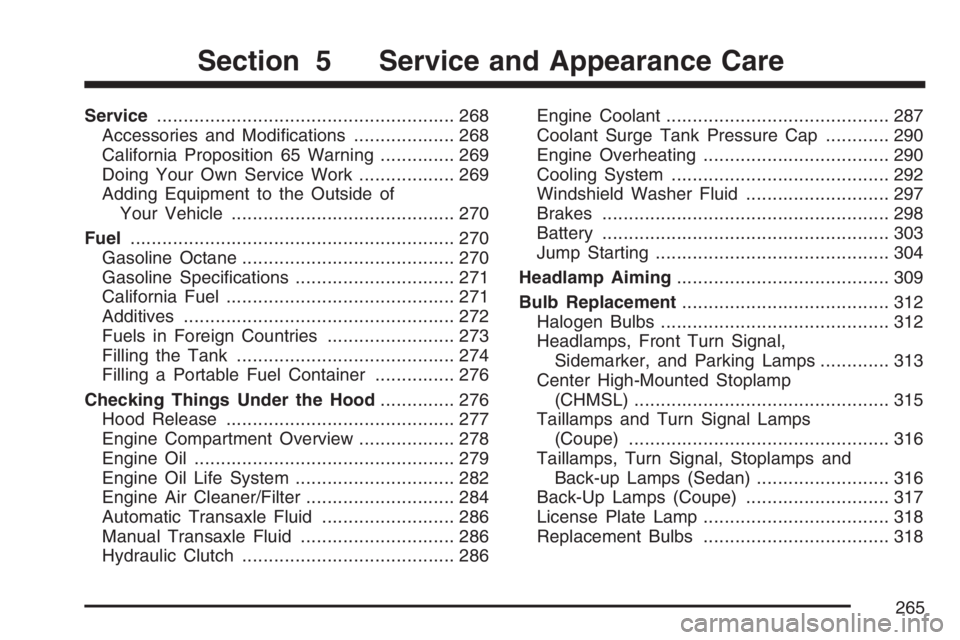
Service........................................................ 268
Accessories and Modi�cations................... 268
California Proposition 65 Warning.............. 269
Doing Your Own Service Work.................. 269
Adding Equipment to the Outside of
Your Vehicle.......................................... 270
Fuel............................................................. 270
Gasoline Octane........................................ 270
Gasoline Speci�cations.............................. 271
California Fuel........................................... 271
Additives................................................... 272
Fuels in Foreign Countries........................ 273
Filling the Tank......................................... 274
Filling a Portable Fuel Container............... 276
Checking Things Under the Hood.............. 276
Hood Release........................................... 277
Engine Compartment Overview.................. 278
Engine Oil................................................. 279
Engine Oil Life System.............................. 282
Engine Air Cleaner/Filter............................ 284
Automatic Transaxle Fluid......................... 286
Manual Transaxle Fluid............................. 286
Hydraulic Clutch........................................ 286Engine Coolant.......................................... 287
Coolant Surge Tank Pressure Cap............ 290
Engine Overheating................................... 290
Cooling System......................................... 292
Windshield Washer Fluid........................... 297
Brakes...................................................... 298
Battery...................................................... 303
Jump Starting............................................ 304
Headlamp Aiming........................................ 309
Bulb Replacement....................................... 312
Halogen Bulbs........................................... 312
Headlamps, Front Turn Signal,
Sidemarker, and Parking Lamps............. 313
Center High-Mounted Stoplamp
(CHMSL)................................................ 315
Taillamps and Turn Signal Lamps
(Coupe)................................................. 316
Taillamps, Turn Signal, Stoplamps and
Back-up Lamps (Sedan)......................... 316
Back-Up Lamps (Coupe)........................... 317
License Plate Lamp................................... 318
Replacement Bulbs................................... 318
Section 5 Service and Appearance Care
265
Page 266 of 428

Windshield Wiper Blade Replacement....... 319
Tires............................................................ 320
Tire Sidewall Labeling............................... 321
Tire Terminology and De�nitions............... 324
In�ation - Tire Pressure............................. 327
Tire Inspection and Rotation...................... 328
When It Is Time for New Tires.................. 330
Buying New Tires...................................... 330
Different Size Tires and Wheels................ 332
Uniform Tire Quality Grading..................... 333
Wheel Alignment and Tire Balance............ 334
Wheel Replacement.................................. 335
Tire Chains............................................... 336
If a Tire Goes Flat.................................... 337
Changing a Flat Tire................................. 338
Removing the Spare Tire and Tools.......... 339
Removing the Flat Tire and Installing
the Spare Tire....................................... 344
Storing a Flat or Spare Tire and Tools...... 349
Compact Spare Tire.................................. 352Appearance Care........................................ 353
Cleaning the Inside of Your Vehicle.......... 353
Fabric/Carpet............................................. 354
Instrument Panel, Vinyl, and Other
Plastic Surfaces..................................... 355
Care of Safety Belts.................................. 356
Weatherstrips............................................ 356
Washing Your Vehicle............................... 356
Cleaning Exterior Lamps/Lenses................ 357
Finish Care............................................... 357
Windshield and Wiper Blades.................... 358
Aluminum or Chrome-Plated Wheels......... 358
Tires......................................................... 359
Sheet Metal Damage................................. 359
Finish Damage.......................................... 359
Underbody Maintenance............................ 360
Chemical Paint Spotting............................ 360
Vehicle Care/Appearance Materials............ 360
Section 5 Service and Appearance Care
266
Page 267 of 428

Vehicle Identi�cation.................................. 361
Vehicle Identi�cation Number (VIN)........... 361
Service Parts Identi�cation Label............... 362
Electrical System........................................ 362
Add-On Electrical Equipment..................... 362
Headlamp Wiring....................................... 363
Windshield Wiper Fuses............................ 363Power Windows and Other Power
Options.................................................. 363
Fuses and Circuit Breakers....................... 363
Floor Console Fuse Block......................... 364
Engine Compartment Fuse Block............... 365
Capacities and Speci�cations.................... 369
Section 5 Service and Appearance Care
267
Page 268 of 428
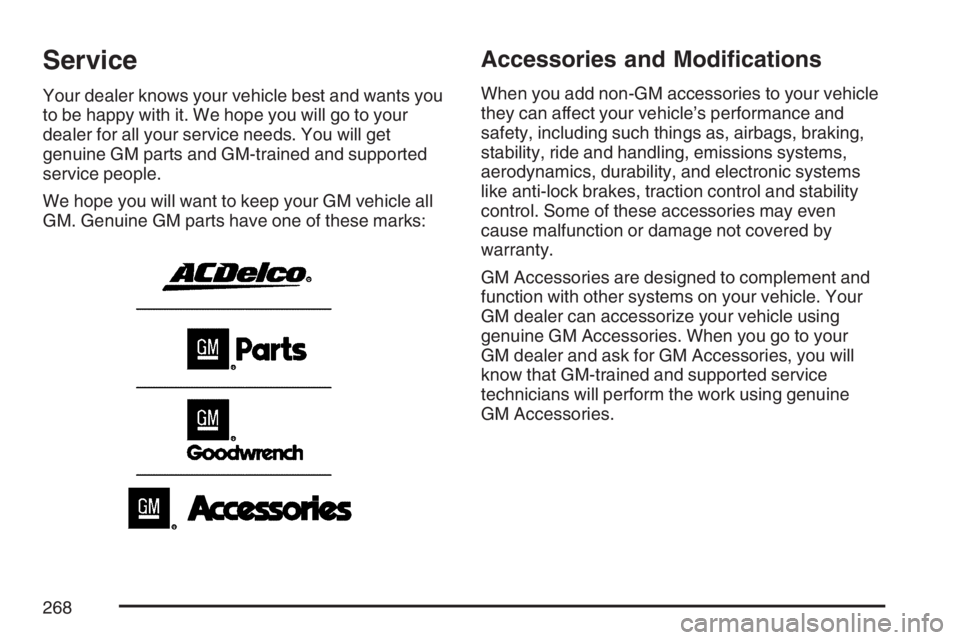
Service
Your dealer knows your vehicle best and wants you
to be happy with it. We hope you will go to your
dealer for all your service needs. You will get
genuine GM parts and GM-trained and supported
service people.
We hope you will want to keep your GM vehicle all
GM. Genuine GM parts have one of these marks:
Accessories and Modi�cations
When you add non-GM accessories to your vehicle
they can affect your vehicle’s performance and
safety, including such things as, airbags, braking,
stability, ride and handling, emissions systems,
aerodynamics, durability, and electronic systems
like anti-lock brakes, traction control and stability
control. Some of these accessories may even
cause malfunction or damage not covered by
warranty.
GM Accessories are designed to complement and
function with other systems on your vehicle. Your
GM dealer can accessorize your vehicle using
genuine GM Accessories. When you go to your
GM dealer and ask for GM Accessories, you will
know that GM-trained and supported service
technicians will perform the work using genuine
GM Accessories.
268
Page 269 of 428

California Proposition 65 Warning
Most motor vehicles, including this one, contain
and/or emit chemicals known to the State of
California to cause cancer and birth defects
or other reproductive harm. Engine exhaust, many
parts and systems (including some inside the
vehicle), many �uids, and some component wear
by-products contain and/or emit these chemicals.
Doing Your Own Service Work
{CAUTION:
You can be injured and your vehicle could
be damaged if you try to do service work
on a vehicle without knowing enough
about it.
Be sure you have sufficient knowledge,
experience, the proper replacement
parts, and tools before you attempt any
vehicle maintenance task.
CAUTION: (Continued)
CAUTION: (Continued)
Be sure to use the proper nuts, bolts,
and other fasteners. English and
metric fasteners can be easily
confused. If you use the wrong
fasteners, parts can later break or fall
off. You could be hurt.
If you want to do some of your own service work,
you will want to use the proper service manual.
It tells you much more about how to service your
vehicle than this manual can. To order the proper
service manual, seeService Publications Ordering
Information on page 410.
Your vehicle has an airbag system. Before
attempting to do your own service work, see
Servicing Your Airbag-Equipped Vehicle on
page 78.
You should keep a record with all parts receipts
and list the mileage and the date of any service
work you perform. SeeMaintenance Record
on page 389.
269
Page 270 of 428

Adding Equipment to the Outside of
Your Vehicle
Things you might add to the outside of your
vehicle can affect the air�ow around it. This may
cause wind noise and affect windshield washer
performance. Check with your dealer before
adding equipment to the outside of your vehicle.
Fuel
Use of the recommended fuel is an important part
of the proper maintenance of your vehicle. To
help keep your engine clean and maintain optimum
vehicle performance, GM recommends the use
of gasoline advertised as TOP TIER Detergent
Gasoline.
The 8th digit of your Vehicle Identi�cation
Number (VIN) shows the code letter or number
that identi�es your engine. You will �nd the VIN at
the top left of the instrument panel. SeeVehicle
Identi�cation Number (VIN) on page 361.
Gasoline Octane
If your vehicle has the 2.2L L4 engine (VIN Code F),
use regular unleaded gasoline with a posted octane
rating of 87 or higher. If the octane rating is less
than 87, you may notice an audible knocking noise
when you drive, commonly referred to as spark
knock. If this occurs, use a gasoline rated at
87 octane or higher as soon as possible. If you are
using gasoline rated at 87 octane or higher and you
hear heavy knocking, your engine needs service.
If your vehicle has the 2.4L L4 engine
(VIN Code B), use premium unleaded gasoline
with a posted octane rating of 91 or higher. You
may also use regular unleaded gasoline rated at
87 octane or higher, but your vehicle’s acceleration
may be slightly reduced, and you may notice a
slight audible knocking noise, commonly referred to
as spark knock. If the octane is less than 87, you
may notice a heavy knocking noise when you drive.
If this occurs, use a gasoline rated at 87 octane or
higher as soon as possible. Otherwise, you might
damage your engine. If you are using gasoline
rated at 87 octane or higher and you hear heavy
knocking, your engine needs service.
270